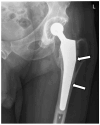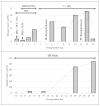Postoperative Thrombocytopenia after Revision Arthroplasty: Features, Diagnostic and Therapeutic Considerations
- PMID: 39337907
- PMCID: PMC11432911
- DOI: 10.3390/life14091124
Postoperative Thrombocytopenia after Revision Arthroplasty: Features, Diagnostic and Therapeutic Considerations
Abstract
We present the case of a 66 year-old male patient who developed severe postoperative thrombocytopenia after revision total hip arthroplasty. The patient underwent surgery in a dedicated orthopedics hospital and was initially managed in the intensive care unit. Upon the development of thrombocytopenia, he was referred to a dedicated hematology clinic for investigation and advanced management. A thorough diagnostic algorithm was employed in order to rule out the main causes of thrombocytopenia. By exclusion, we diagnosed the patient as suffering from a rare and severe form of postoperative thrombocytopenia through an immune mechanism. Although postoperative thrombocytopenia is relatively frequent but transitory and no treatment is required, this condition was refractory to corticosteroids and substitution therapy; however, it quickly responded to treatment with thrombopoietin receptor agonists. The patient recovered and was successfully discharged with normal platelet values. While rare occurrences, alternative causes of thrombocytopenia such as infection, drug-induced, or immune should be considered in patients developing postoperative thrombocytopenia.
Keywords: disseminated intravascular coagulation; drug-induced; immune mechanism; immune thrombocytopenia; orthopedics; pathophysiology; platelets; postoperative thrombocytopenia.
Conflict of interest statement
The authors declare no conflicts of interest.
Figures








References
-
- George J.N., Woolf S.H., Raskob G.E., Wasser J.S., Aledort L.M., Ballem P.J., Blanchette V.S., Bussel J.B., Cines D.B., Kelton J.G., et al. Idiopathic thrombocytopenic purpura: A practice guideline developed by explicit methods for the American Society of Hematology. Blood. 1996;88:3–40. doi: 10.1182/blood.V88.1.3.3. - DOI - PubMed
Publication types
LinkOut - more resources
Full Text Sources

